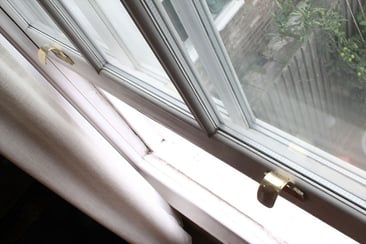
Passive cooling methods keep the temperature inside a building comfortable without using energy-hungry air-conditioning, fans or heat pumps. Cooling is needed during the...

Ventilation is extremely important as without adequate ventilation the building would be uninhabitable, high levels of CO2 would cause occupants to be lethargic and get headaches, while high humidity levels would cause damp leading to mould and potentially damage to the building structure itself. On top of this there would be smells to contend with.
Consequently building regulations require a building to be adequately ventilated. This requirement has become more challenging as building construction has improved and as modern buildings are built to high air tightness standards (air tightness is discussed in a previous blog post).
To understand these changes we need to understand how buildings lose heat. In essence, this is through fabric losses (i.e. walls, roof, floor and windows) and via uncontrolled ventilation losses (drafts) - think of the wind whistling through a sash window or up through a drafty suspended floor. For exposed buildings ventilation losses can represent over 50% of the buildings heat loss.
The ventilation challenge is to ensure that the building remains fresh and healthy and at the same time heat losses from ventilation are minimised.

There are 4 main ventilation strategies outlined in Part F of the building regulations:
Trickle vents and extractor fans - trickle vents are in the ‘dry rooms’ (bedrooms and living rooms - often in windows) and extraction fans are in the ‘wet rooms’ (bathrooms and kitchen).
Trickle vents and passive stack - this works with a pipe running vertically out of the top of the building. The wind passing over the pipe or ‘stack’ creates a venturi effect (low pressure in the pipe) and this coupled with buoyancy of the warmer air in the building draws the internal air up through the stack and out of the building.
Mechanical extract ventilation (MEV). Again this uses trickle vents in dry rooms and then has a single central extractor fan taking air out of all the wet rooms.
Mechanical ventilation with heat recovery (MVHR) this passes air from the wet rooms through a heat exchanger where the heat is remove and the now cold air is exhausted outside. The heat is moved into fresh air that is brought in from outside, to warm it prior to it entering the dry rooms.

All these systems are have advantages and disadvantages and will no doubt be up for discussion for future blog posts. It is also possible to modify these core strategies. Common examples are:
Demand Control Ventilation (DCV) this is when there are automatically controllable trickle vents and / or extractor fans. These only need to be opened when there are ‘pollutants’ in the room and the rest of the time they remain closed minimising heat loss.
Another is the use of a heat pump on a MEV system which takes the exhaust air’s heat and uses it to heat the domestic hot water. These system can work highly efficiently as they work for you all year around, not just in winter.
Windows (particularly roof lights) often allow partial opening which can be used to ventilate a room in a similar way to DCV.
Ventilation can not be viewed in isolation as it has a large impact on space heating and in low energy buildings this also has an impact on the hot water heating system. At the design stage these should all be considered together. The chosen ventilation system will also have an impact on the SAP calculation that is required for building regulation compliance.
So far this blog has considered background ventilation. The building regulations also specify a second type of ventilation: purge ventilation. Purge ventilation requires high volume air flow through the building and is typically achieved by opening a window. Purge ventilation can be used to cool a building and remove odours caused by infrequent events e.g. burning the toast. Purge ventilation will be covered in a separate blog.
Find out more about how smart building controls can help with ventilation here.

Condensation is not only an annoying form of damp, but it can also actually harm your property. Rotting wood, mould, damaged plaster, peeling wallpaper and even health...